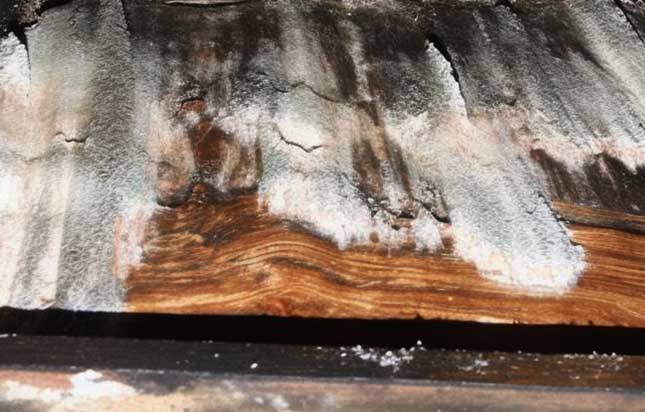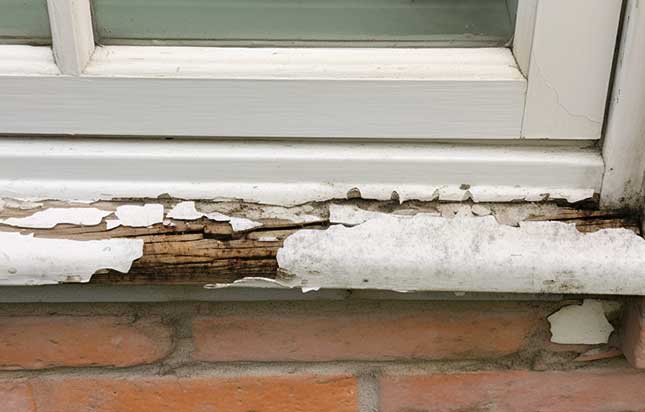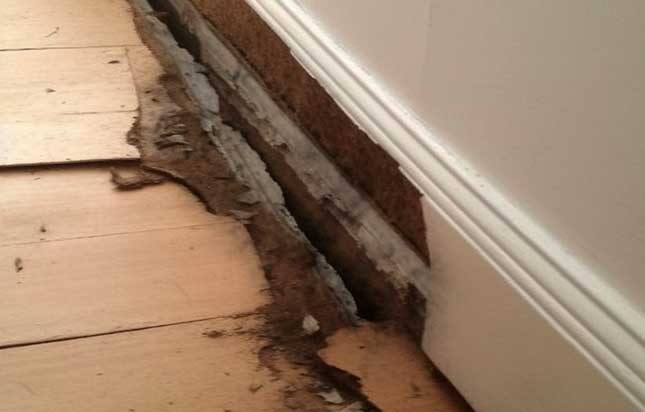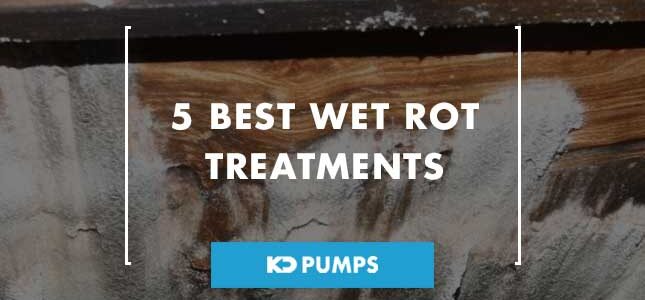5 Best Wet Rot Treatments
Wet rot is a concern faced by many homeowners, and has the potential to cause significant damage if wet rot treatments are not applied quickly and effectively.
It’s crucial to grasp the reasons why it happens, the methods for identification, and the treatments that work best.
In this article, we will cover everything about wet rot, starting from its roots and extending to the most efficient wet rot treatments.
Understanding wet rot is key to safeguarding your home from its detrimental effects.
Article Chapters
What is Wet Rot?
Wet rot, a common issue in many homes, is a form of fungal decay that specifically targets timber, and manifests in areas with high moisture content, creating a breeding ground for fungi.
Wet rot fungi feed on the cellulose component of wood.
When moisture levels rise above 20%, providing an ideal habitat for these fungi, the wood becomes susceptible.
The most common cause of wet rot is three main types of fungi:
Mycelium

Mycelium is evidence of wet rot
Mycelium serves as the initial ominous sign of a potential wet rot problem.
This fungal growth materialises as a cotton-wool-like substance that grows across damp timber surfaces.
When you spot mycelium, it’s a clear indication of excessive moisture in the wood.
This soft, fluffy mass is essentially the wet rot fungi’s roots, signalling the beginning stages of decay.
Mycelium often goes unnoticed until it spreads visibly, emphasising the importance of regular inspections to catch it early.
Coniophora Puteana
Coniophora Puteana, one of the common wet rot species, frequently finds its breeding grounds in poorly ventilated subfloor areas.
It’s distinctly identifiable by its string-like appearance, resembling strands of dark brown spaghetti in affected timber.
This form of wet rot thrives in environments where ventilation is lacking, making subfloors, cellars, and other enclosed spaces vulnerable.
Coniophora Puteana’s presence often indicates not only dampness but also inadequate airflow, creating a recipe for fungal growth.
Poria Vaillantii
Poria Vaillantii is recognizable by the white, velvety mycelium it produces.
As it infiltrates timber, it leaves a trail of brown, cubical-shaped fractures in its wake.
These fractures, a telltale sign of Poria Vaillantii’s presence, mark the structural integrity of the wood being compromised.
Unlike some other wet rot species, Poria Vaillantii doesn’t discriminate; it can invade various types of wood, making it a versatile and potentially destructive force.
What are the Main Causes of Wet Rot?
Wet rot has a variety of causes, some of the most common being:
Leaky Roofs
One of the most notorious enablers of wet rot is a leaky roof.
When roofs are compromised, be it due to damaged shingles, cracked tiles, or improperly sealed seams, rainwater seeps into the structural framework.
This persistent dampness saturates the timber, providing the ideal moisture content for wet rot fungi to thrive.
Unattended roof leaks can lead to extensive internal damage, making prompt repairs vital to prevent wet rot from taking hold.
Faulty Plumbing
Faulty plumbing can be one of the most common causes of wet rot.
Leaking pipes, dripping faucets, or compromised connections create hidden pockets of moisture within walls and floors.
Over time, these concealed damp areas become breeding grounds for wet rot fungi.
Identifying and repairing plumbing issues promptly not only conserves water but also safeguards the structural integrity of the building.
Poorly Sealed Windows

Poorly sealed windows can cause wet rot
Windows, if not properly sealed, can usher in more than just light and air.
Improper seals allow rainwater to infiltrate the window frames, leading to dampness within the walls.
Over several seasons, this moisture accumulates, creating a conducive environment for wet rot.
Regular checks of window seals and swift resealing when necessary act as preventive measures, impeding the entry of excess moisture.
Damp Basements
Basements are inherently more susceptible to moisture due to their subterranean nature, and are prime locations for wet rot development.
Poor basement drainage, ineffective waterproofing, or high groundwater levels can lead to persistent dampness in basements.
This damp atmosphere encourages wet rot, making basements an area of the house demanding vigilant maintenance.
Proper waterproofing measures, adequate ventilation and effective basement flooding solutions are essential for preserving basement spaces.
How is Wet Rot Identified?
Identifying wet rot is a crucial skill for homeowners, as early detection can prevent extensive damage.
By understanding the key indicators, you can swiftly address the issue. Here’s how you can spot wet rot in your home:
Changes in Timber Appearance
One of the first signs of wet rot is visible changes in timber.
Affected wood typically appears darker than its normal hue, often taking on a deep brown or black shade.
This darkening is a direct result of the fungi’s activity, breaking down the wood’s fibres and altering its colour.
By comparing the suspected timber with unaffected wood, these changes become more apparent.
Texture Alterations
Wet rot compromises the structural integrity of timber.
As the wood deteriorates, it becomes noticeably softer than its healthy counterparts.
When you touch the affected area, it might feel spongy or crumbly.
This softening is a clear indication that the wood fibres are breaking down due to fungal activity.
Comparing it to nearby unaffected wood can help you discern the difference in texture.
Musty Odour
Wet rot often emits a distinctive musty smell.
This smell is a result of the metabolic processes of the fungi breaking down the wood.
If you notice an unexplained, damp, or earthy smell in a particular area of your home, especially near timber structures, it’s a cause for concern.
Investigating further in the direction of the odour can lead you to the source of the wet rot.
Visual Evidence

Identifying wet rot can be done with a simple check
Beyond changes in colour and texture, wet rot can manifest visually.
You might observe cracks or splits in the affected timber, indicating that it’s losing its structural integrity.
In severe cases, the wood might even crumble into powdery fragments.
Additionally, the presence of fungal growth, resembling cotton wool or mushroom-like structures, is a definitive sign of wet rot.
These growths often accompany the deteriorating timber and confirm the presence of fungal activity.
Proximity to Moisture Sources
Assess the affected timber’s proximity to potential moisture sources.
Areas near leaky pipes, poorly sealed windows, or damp basements are more susceptible to wet rot.
If you identify compromised timber close to these moisture-prone areas, it heightens the likelihood of wet rot being the cause.
The Best Wet Rot Treatments
Dealing with wet rot demands a strategic approach, ensuring that the existing infestation is eradicated.
Here are the best wet rot treatments that homeowners can employ:
Drying Out
The fundamental step in wet rot treatment is addressing the root cause: moisture.
Identifying and fixing leaks, improving ventilation, and utilising dehumidifiers are essential.
By reducing moisture levels, you create an inhospitable environment for the fungus, hindering its growth and preventing further decay.
Fungicidal Treatments
Applying a fungicidal solution directly targets the existing fungus.
Boron-based products are highly effective against wet rot.
These solutions penetrate the affected timber, eradicating the fungi and halting their destructive activity.
Regular applications as per the manufacturer’s guidelines can ensure comprehensive elimination.
Replacement of Severely Damaged Timber
In cases where wet rot has extensively damaged timber, replacement becomes necessary.
Rotted wood should be removed and replaced with new, treated timber.
It’s vital to choose timber that is specifically treated with preservatives, safeguarding it against future infestations.
Proper installation, including sealing joints and ensuring adequate ventilation, is crucial to prevent recurrence.
Epoxy Resins
Epoxy-based resins offer an innovative solution for reinforcing weakened timber structures.
These resins effectively stabilise compromised wood, preventing further decay and enhancing structural integrity.
By sealing vulnerable areas, epoxy resins create a barrier against moisture, impeding the growth of fungi.
Professional application ensures a durable and long-lasting reinforcement, safeguarding your home from future wet rot issues.
Professional Assistance
For severe or widespread wet rot infestations, seeking professional help is paramount.
Experienced specialists can assess the extent of the damage comprehensively.
They utilise advanced diagnostic tools to identify hidden pockets of decay.
Professional treatments, often combining fungicidal solutions, epoxy resins, and preventive measures, ensure a thorough and lasting resolution.
Additionally, experts can provide valuable guidance on preventive strategies, helping homeowners safeguard their properties against future threats.
How Can Wet Rot be Prevented?
Preventing wet rot is a proactive endeavour that involves meticulous maintenance and strategic protective measures.
By creating an environment hostile to excessive moisture, homeowners can effectively safeguard their properties from this insidious fungal decay.
Here are essential strategies to prevent wet rot and ensure the longevity of your home:
Regular Property Inspections
Conduct routine inspections of your property, focusing on vulnerable areas like the roof, windows, and foundation.
Regular checks can help you identify potential issues such as leaks, broken seals, or damaged roofing tiles promptly.
Addressing these problems early prevents water ingress, a primary catalyst for wet rot.
Effective Ventilation
Proper ventilation is paramount in preventing the buildup of moisture within your home.
Ensure that spaces like attics and basements are well-ventilated.
Adequate airflow prevents humidity buildup, reducing the risk of dampness that fosters wet rot.
Consider installing vents, fans, or dehumidifiers in areas prone to stagnating air.
Damp-Proofing Measures
Invest in damp-proofing techniques to create a barrier against moisture infiltration.
Damp-proof membranes, coatings, and sealants can be applied to foundation walls and other vulnerable surfaces.
These measures prevent water seepage into the structure, eliminating the conditions conducive to wet rot development.
Water-Resistant Coatings
External woodwork, such as doors, windows, and wooden cladding, is susceptible to moisture exposure.
Applying water-resistant coatings or paints creates a protective shield, reducing the wood’s vulnerability to dampness.
These coatings act as a barrier, preventing rainwater absorption and minimising the risk of wet rot.
This can be one of the more simple, but highly effective wet rot treatments.
Proactive Repairs
Promptly address any signs of wear, damage, or decay in the exterior elements of your home.
Repair broken roof tiles, damaged seals, or cracked foundations immediately.
Timely repairs prevent water intrusion, preserving the integrity of your property and thwarting potential wet rot growth.
Landscaping Considerations
Landscaping elements such as proper grading, drainage systems, and well-maintained gutters play a pivotal role in moisture management.
Ensure that rainwater is directed away from the foundation through appropriately graded landscapes and functioning gutter systems.
Redirecting water flow prevents pooling around the property which helps stop waterlogged gardens and minimises the risk of dampness and wet rot.
Regular Maintenance
Regular maintenance is the cornerstone of wet rot prevention.
Keep gutters and downspouts clean and unclogged, ensuring efficient water drainage.
Trim branches and foliage away from the house, preventing excess shade that promotes dampness.
By staying vigilant and proactive in your maintenance efforts, you create an environment hostile to wet rot, preserving your home’s structural integrity for years to come.
Conclusion
Understanding wet rot, its causes, and the best wet rot treatments are essential for every homeowner.
By being vigilant, addressing moisture issues promptly, and employing suitable treatments, you can protect your property from the destructive force of wet rot.
Remember, early detection and professional advice are your best allies in this battle against fungal decay.


Comments are closed.